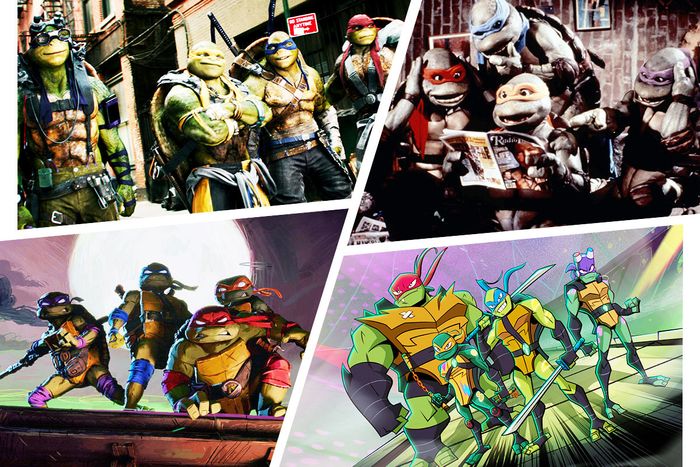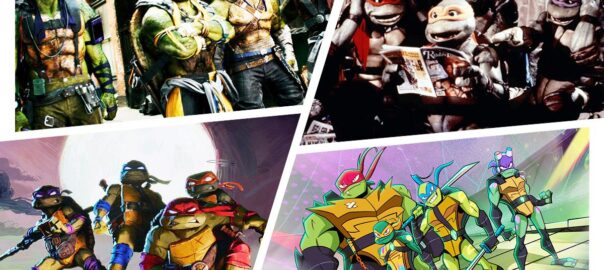[ad_1]

Photo-Illustration: Vulture; Photos: Everette Collection
Admit it: You’re already singing the theme song. That’s the power of the Teenage Mutant Ninja Turtles, characters who were originally meant to be a parody of various superhero trends before becoming trendsetting superheroes themselves. There’s no way that creators Kevin Eastman and Peter Laird could have imagined that their 1984 black-and-white indie comic book would launch a decades-spanning media empire, but the Turtles have now served as touchstones for multiple generations, beginning with their mega-popular 1987 cartoon series. The four mutated turtles — named after Renaissance artists Leonardo, Donatello, Michelangelo, and Raphael — were initially conceived as dark and violent, but they were toned down and targeted at kids by the time they hit TV screens.
The pizza-loving Turtles — along with their mutated rat mentor, Splinter; their archnemesis, Shredder; and their reporter ally, April O’Neil — have a spotty history at the movies, from their record-breaking 1990 live-action debut through a variety of straight-to-video productions. With the new Teenage Mutant Ninja Turtles: Mutant Mayhem hitting theaters this week, here’s a look at how the Turtles’ cinematic oeuvre measures up.
The sequel to the Michael Bay–produced 2014 live-action reboot overcorrects for the first movie’s bombastic seriousness, delivering an obnoxious, exhausting distortion of the Turtles’ animated incarnations. The photorealistic CGI versions of warthog and rhinoceros mutants Bebop and Rocksteady and slimy-brained alien Krang are hideous and abrasive, and they make for weak villains even when added to mad scientist Baxter Stockman (Tyler Perry, for some reason) and the return of Shredder (Brian Tee). As April, Megan Fox is even further marginalized and objectified, at one point placed into a situation that conveniently requires her to don a schoolgirl outfit. The only thing more disheartening than the joke about Bebop’s warthog-size, er, warthog is the presence of Laura Linney attempting to bring gravitas to this nonsense as the NYPD chief.
The first Bay-produced live-action theatrical release is slightly more tolerable than its sequel, although it makes the Turtles almost secondary characters to Fox’s April and her sleazy, incel-adjacent cameraman, Vern Fenwick (Will Arnett). April gets her own needlessly tragic backstory, adding in anguish that Fox can’t quite pull off. That also ties her to the origins of the Turtles and Splinter (voiced here by a miscast Tony Shalhoub), which loses some of the fun of their offbeat human-mutant friendship. Director Jonathan Liebesman relies on Zack Snyder–style speed-ramping in the chaotic action sequences, and his version of Shredder (Tohoru Masamune) looks like he belongs in one of Bay’s Transformers movies. The Turtles themselves, infamously redesigned so that they have human-looking lips, are more off-putting than endearing, and they don’t get enough screen time to assert their individual personalities. William Fichtner makes for an effective villain as an evil industrialist who teams up with Shredder, but his master plan is a bit too grim for a Ninja Turtles movie. It’s an awkward mix of action-movie bluster and cartoon exuberance.
The initial wave of Turtle-mania was already winding down by the time the third movie in the original live-action series was released in theaters, and it’s easy to see that producers were running out of ideas. After two movies set in a charming movie-backlot version of New York City, the third installment sends the Turtles back in time to 17th-century Japan. That could have been a chance for them to team up with their sometime-ally Usagi Yojimbo, the rabbit samurai, but instead they face off against some dull British imperialists and an ineffectual warlord. Elias Koteas’s vigilante Casey Jones makes a welcome return only to be sidelined to babysit some Japanese warriors who get stuck in the present, while Koteas inexplicably also plays a scheming British soldier in the past. The animatronics are noticeably stiffer compared to the first two movies, as All Effects Company took over Turtle duties from Jim Henson’s Creature Shop. The incessant, inane pop-culture references, including the Turtles “schwing”-ing at April (Paige Turco), are just as stiff.
Netflix stepped in two years after the conclusion of Nickelodeon’s animated Rise of the Teenage Mutant Ninja Turtles TV series with an original movie that served as a series finale — though it also worked as a standalone introduction to the show’s different approach to the characters. Most notably, the typical personalities for Leonardo (Ben Schwartz) and Raphael (Omar Miller) have been essentially reversed, with Leonardo as the arrogant loner and Raphael as the level-headed leader. In another major change, these Turtles also have mystical powers, and the movie is a jumbled sci-fi epic involving Casey Jones (Haley Joel Osment) being sent back in time to prevent the alien Krang race from taking over the Earth. This April (Kat Graham), now a student at East Laird University, gets to be more proactive than some previous incarnations, but all the characters get lost in the frenetic, repetitive action. The hyperactive animation style fits with Schwartz’s hyperactive performance, and it’s all a little overbearing, much like Leonardo himself.
This animated production, released in theaters between the two live-action film series, often gets overlooked, but it’s a respectable attempt to launch a new Turtles franchise with some more grounded characterization. The Turtles themselves are somewhat angsty, especially Leonardo (James Arnold Taylor) and Raphael (Nolan North), whose feud culminates in an atmospheric, well-staged rooftop fight. The scattered Turtles need to come together against the threat of a group of ancient revived warriors, led by an immortal warlord posing as high-powered tycoon Max Winters (Patrick Stewart). Winters also hires April (Sarah Michelle Gellar), who gets reimagined as a globetrotting Lara Croftian adventurer, in a romantic relationship with Casey Jones (Chris Evans). The interpersonal drama is more engaging than the conflict with the poorly defined villains, although Stewart brings some melancholic dignity to his world-weary schemer. Nickelodeon’s 2009 purchase of the Turtles characters put an end to potential sequel plans, but there probably wasn’t enough here for a viable theatrical franchise.
Multiverses are everywhere now, but the Turtles were ahead of the game with their equivalent of Spider-Man: Into the Spider-Verse in this TV movie created to celebrate the franchise’s 25th anniversary. The Turtles from the 2003-2009 animated TV series team up with the Turtles from the original 1987-1996 animated TV series when a portal accidentally opens between their two realities. That leads to plenty of good-natured mockery of the cheesy ridiculousness of the original cartoon, including April’s notorious yellow jumpsuit and some of the more absurd villains. The 2009 Turtles are only slightly less ridiculous than their vintage counterparts, and the two quartets team up against the newer version of Shredder, who’s determined to destroy all realities. “The Turtle-verse is, like, ginormous,” observes Michelangelo, and the movie eventually expands to include the Turtles from Eastman and Laird’s early comic books, along with live-action cameos from the creators themselves. It’s gleefully self-referential, but still produced on a Saturday-morning cartoon budget, without the resources for the truly grand scope it warrants.
It’s tough to encapsulate just how popular the Turtles were when they first came to the big screen, thanks to animatronic suits created by Jim Henson’s Creature Shop. This live-action adaptation attempts to balance the grittiness of Eastman and Laird’s comic books with the goofiness of the hit cartoon series, with mixed success. Even so, the collaboration among stunt performers, puppeteers, and voice actors required to bring each Turtle to life is quite impressive, and those characters are corny but likable. Kevin Clash nearly overshadows them with his serene, wry version of Splinter, which may be the rat sensei’s best onscreen depiction. Among the human characters, Judith Hoag is perhaps too sour as April, but Koteas is perfectly cast as Casey Jones, bringing his innate intensity to the hockey mask-wearing vigilante. Director Steve Barron channels The Warriors in his exaggerated depiction of New York City, and Shredder (played by James Saito and voiced by David McCharen) carries the right amount of menace, while sticking with the movie’s kid-friendly approach.
After the massive success of the first live-action movie, this sequel was able to recruit the biggest star in the world: Vanilla Ice. Ice’s “Ninja Rap,” performed in a nightclub as the Turtles fight members of the sinister Foot Clan, is awesomely terrible, but its enthusiastic silliness fits with the tone of the movie, which is lighter than its predecessor but still focused on action. That action tends more toward slapstick this time, recalling both Buster Keaton and Jackie Chan, and is often punctuated with wacky sound effects. The Turtles learn more about their radioactive origins, as Shredder kidnaps a flustered scientist (David Warner) involved in the creation of the radioactive “ooze” that transformed them. Shredder uses the ooze to create the mutants Tokka and Rahzar, which showcase inventive work from the Creature Shop rather than just copying designs from the cartoons. On the human side, the newly recast Paige Turco makes for a more appealing April than Hoag, and Warner delivers the techno-babble with admirable conviction. It all starts with an opening montage of New Yorkers eating pizza that is emblematic of the movie’s inclusive sense of fun.
Thanks to its elaborate, almost painterly animation style, Mutant Mayhem is easily the most visually distinctive Ninja Turtles movie, and it features some heartfelt characterization as well. These Turtles are voiced by actual teenagers, giving them an earnest vulnerability along with their typical relentless energy. That also allows for plenty of try-hard youth-culture references, which only succeed about half the time. Some of those come from April (Ayo Edibiri), who is a teenager here, too, equally concerned about the potential cancellation of prom as she is with the threat posed by mutant villain Superfly (Ice Cube). Superfly and his team of fellow mutants look enjoyably grotesque, although his evil plan is a little underwhelming. As co-writer and co-producer (and the voice of warthog mutant Bebop), Seth Rogen brings an off-kilter sensibility to the otherwise straightforward reboot, offering something for both nostalgic adult TMNT fans and kids just getting into the franchise.
The unlikely crossover is a comic-book staple, and this direct-to-video animated movie adapts a popular DC Comics/IDW series that brought the Turtles together with the Caped Crusader. They turn out to be a perfect combination, both in their initial confrontation and in their later team-up against an alliance of Shredder (Andrew Kishino) and Batman villain Ra’s al Ghul (Cas Anvar). Writer Marly Halpern-Graser and director Jake Castorena play to the strengths of both sets of characters, allowing Batman (Troy Baker) to easily beat the Turtles when they first meet, before realizing they could prove to be valuable allies. The animation is bright and expressive, the use of mutated versions of Batman villains is inspired, the humor is genuinely clever, and the story even finds room for sweet character moments for Batgirl (Rachel Bloom) and Robin (Ben Giroux). Plus, Batman says “Cowabunga!” and “It’s pizza time!” What more could you want?
[ad_2]
Source link
